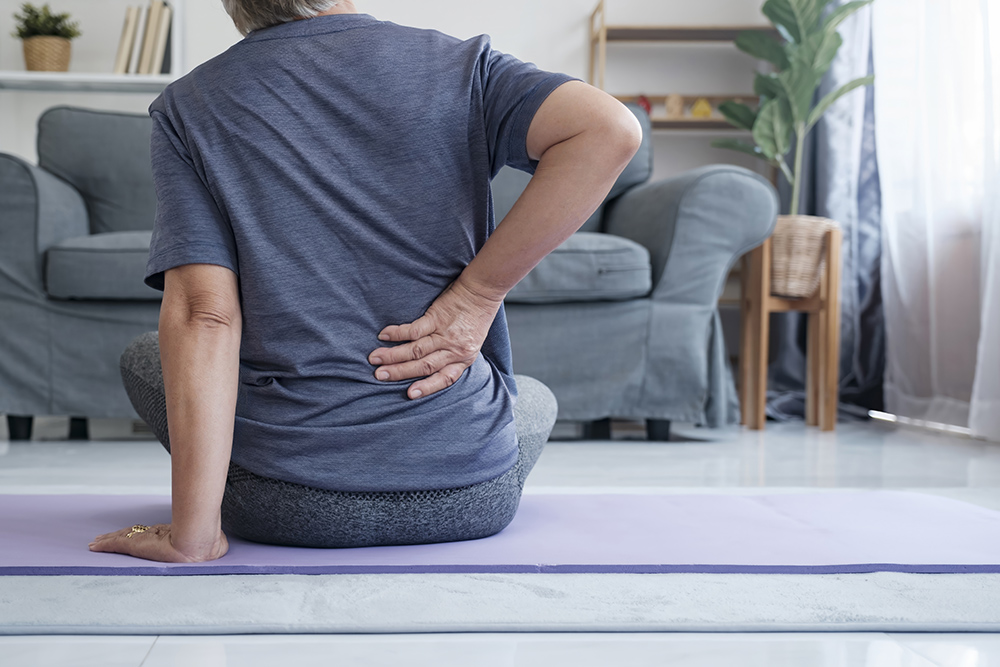Contents
Experiencing chronic lower back pain? The cause could be lumbar radiculopathy, also known as sciatica. Radiculopathy refers to an injury or other kind of damage to your nerve roots. Sometimes called a pinched nerve, this can cause tingling and painful burning sensations. The lumbar region is the area of the lower back. Radiculopathy in this region can be challenging to deal with, leading to symptoms like persistent pain and numbness. When the time comes to seek treatment, physical therapy can be a great choice. There are a range of physical therapy treatments geared toward treating sciatica. These include targeted exercises to manage lumbar radiculopathy. Engaging in lumbar radiculopathy exercises can be an excellent way to manage your symptoms between in-person physical therapy sessions. By learning how to practice some top exercises for lumbar radiculopathy, you can take part in boosting your own recovery.
Top exercises for lumbar radiculopathy
- Child’s pose — The child’s pose is a common stretch originating in yoga traditions. The pose stretches your lower back, which can help relieve tension in the spine. To do this pose, kneel on the floor with your big toes touching. Your knees should be spread apart, forming a V shape with your feet. Sit back on your heels. Then extend your arms forward and lower your chest toward the floor. Try to pull your fingers forward and away from your hips until you feel a stretch in your lower back. If you want to rest your arms, you can pull them behind your legs while keeping your chest extended and lowered. Try to hold this position for around 30 seconds before each reset.
- Knee to chest — The knee-to-chest stretch is a great simple exercise for lumbar radiculopathy. To begin, keep your feet flat on the floor and lie on your back. Your knees should be bent and pointing at the sky. From this position, pull one knee in toward your chest. Grip the knee with both hands to help pull it tight. Hold this stretch for 20 to 30 seconds before releasing. You can alternate legs with this exercise, repeating around three times on each side per session. This exercise can help relieve pressure on the sciatic nerve, making it an effective way to manage lumbar radiculopathy.
- Seated forward bend — In addition to helping the lower back, this stretch can also relieve tension in the hamstrings. Start with your legs extended in front of you while sitting on the floor. Keeping your hips static, try to touch your toes with your fingers. Reach as far as you can comfortably manage; then hold for around 20 seconds. You can repeat this exercise on both legs at the same time or alternate legs with each repetition. By stretching the lower back, this exercise can be a great way to relieve lumbar radiculopathy pain.
- Wall squats — Wall squats are a quick and simple exercise that can lead to major positive results. Begin in a standing position with your back against a wall. Lean into the wall gradually, keeping your feet planted hip width apart. Slowly slide down the wall, bending your knees until they are at a 90-degree angle. You should look as if you are sitting in an invisible chair. Try holding this position for 10 to 15 seconds; then slide back up the wall. See if you can repeat the squat 10 times total. This exercise works to address lumbar radiculopathy by strengthening the lower back muscles. Wall squats target the gluteal muscles and quadriceps in particular. Improving strength in this region can help your muscles provide better lower back support.
- Piriformis stretch — The piriformis muscle is a rotator muscle located in the hip. When this muscle is tight, it can compress the sciatic nerve. This can lead to lumbar radiculopathy. With exercises that stretch the piriformis muscle, you can address this compression and help prevent future dysfunction in the muscle. Start by lying on your back, knees bent and feet flat. Then cross your left ankle over your right knee. Use your hands to pull your right thigh toward your chest. You should feel a slight stretch in both legs and your hips. Hold for around 30 seconds; then swap legs.
Learn more lumbar radiculopathy exercises and find relief with Lattimore Physical Therapy
Physical therapy exercises can be a great way to address the root causes of your sciatica. At Lattimore Physical Therapy, we can guide patients through a range of targeted exercises designed to relieve lower back pain. With a personalized treatment plan, you can work toward a long-term solution for your sciatica symptoms.
Contact our team today for more information or to schedule an initial appointment.



